Popular Highlights
When only a watchmaker will do
Restoration of Omega Jump Seconds Clock
Notes for Young Watchmakers and Recent Graduates
This is under construction and is intended to be a running log of helpful info and links to pages that offer more detail.
I have been told by several graduates that their schools use my site as a resource. That is much more than I intended.
I started teaching a young graduate who works in a service center for an exclusive brand. He wants to learn restoration and as many of you know, the opportunities for learning that aspect of this work are very limited in today's world. The brands want to sell new product and provide expeditious service. This means there are not many chances for you to expand upon the skills you acquired in school.
Also, given the parts restrictions, there is no way you can put bread on the table with routine after-sales service while learning and becoming known in restoration.
I will use this section of the website to provide more detail for how I work. If you have specific questions you can feel free to email me; but do not be disappointed if I do not respond directly. If I have time, I will. If your question seems to be something that others should know, I will write about it here.
I will assume you have gone through the website and I will not rehash the basics, but instead try to go into more detail.
New Section on Measurement in Watchmaking
New Section on Lathes and Collets for Watchmakers
Equipping the Shop for Cleaning and Other Operations
Health and long-term effects: Thirty or 40 years is a long time. At 62 I was diagnosed with an asthma after I routinely got into respiratory crisis carrying my chainsaw up hills that I ran up in the recent past. Is this from lack of ventilation? (Neither my wife nor I smoke.)
This also applies to skeletal issues. Carpal tunnel, tennis elbow and all of that are avoidable by setting up your bench correctly. And follow the Swiss method: get outdoors! A watchmaker who is out of shape has less fine motor coordination and is not at her/his mental best.
Be prepared for physical changes. The reason I started using a microscope at the bench was because I developed cataracts. Now that I had them corrected, I will still use the scopes. Both at the turns and at the bench, the microscopes reinforce excellent posture.
Work to Avoid: Hopefully you know that makers current production watches do not make parts available to independent watchmakers. In fact, many watchmakers with long time relationships are having their accounts closed by the major brands.
There is one VERY important point to adhere to. EVEN if the watch does not need parts, many of the case parts are "one time use"; they are intended to fall apart upon removal. This is especially true with hands. If you do not have access to case parts, refuse the work. Watches prior to 2000 are pretty safe; but even then ensure your customer knows you may need to use aftermarket parts whish fit and function perfectly.
Removal techiniques: Many dials and hands are damaged by a thought less approach to disassembly. Use a dial protector. It need not and should not be Bergeon; find a roll of 35mm film and use that to make dial protectors. The plunger style hand removers are useless. For seconds hands I frequently use a Boley "D" tweezer specially sharpened and kept for this purpose. Otherwise use levers. If you are reading this site, you can probably make a set of your own levers rather than over $100 for hand levers.
When it comes to chronograph driving wheels, these are frequently fitted way too tight by the guy before you, First, do NOT use those plunger style wheel removers. If the wheel is too tight, you are going to damage the wheel. First try to turn the wheel counter clockwise. If it moves independently of the arbor you can "screw" it off.
If it does not, it is on too tight and any additional effort will shear the arbor or even break a pinion. Use a clean soldering iron or gun to expand the brass hub on the arbor until you can turn it.
I showed them how to do this in class in Neuchatel, but I was laughed at. On my exam piece (an 861 prepared by students in the two year program) the driving wheel was force fit on. I did not ask for the soldering gun and did as instructed in class. I BROKE the 4th and 3rd pinions and was "charged for them. Never again!
Attitude and mood: First, you are human and there are days you just can't stop making mistakes. Walk away and stop wasting your time. Do something less exacting.
If you want to excel, you have to be brutally honest with your work and results. Do not rely on someone else to point out what you missed; if they can find it you should have found it. I think a number of watchmakers hate timing machines because they make the results crystal clear. Every timepiece should have a respectable final report of amplitude and positional rates. If it does not, discipline yourself to track down the reason. That in itself will improve your technique.
I once accompanied some young watchmaking students to Eta 7750 factory training in Switzerland. They were given the opportunity to buy a 7750 kit for completion at home. One of them later came to visit me with his watch on his wrist, explaining how "only" one function did not work. Do not be that guy!
And I tell everyone, it takes at least 15 years to become a useful watchmaker; or really any other specialist. Think about it, 2 years of school, 3 or 4 years of learning the basics of after-sales service. If you are lucky, you were exposed to the myriad of casing design and movement idiosyncrasies. But now you want to move into repeater work and become skilled in making parts. You must find the books, tools, equipment and hopefully a mentor. By the time you find the equipment and learn how to use it, it will have been around 15 years. Get over it.
Documentation: Service centers document watches upon receipt with photographs. There are several good reasons for you to do this. First, it ensures you send back the correct piece! Secondly, it can help resolve disputes about the condition of the piece. Thirdly, and most importantly, it enables you to show customers what you find upon inspection. When I find cracked jewels or such, I take photographs and send them to the customer. Not only does this document your findings, but it provides an opportunity to educate the customer. This is especially useful when you find damage due to failed lubricants.
I have a Bausch and Lomb StereoZoom 7 (10X to 70X) for close inspection and taking photos for customers (Very easy with a tilt screen camera like a Nikon D750). If you have a tilt screen camera, today you can take very high quality microphotographs that were beyond the reach of most individuals only 20 years ago and with much less setup. I happen to have a scope with a dedicated camera port, but you can use an eyepiece tube just as easily with the same results.
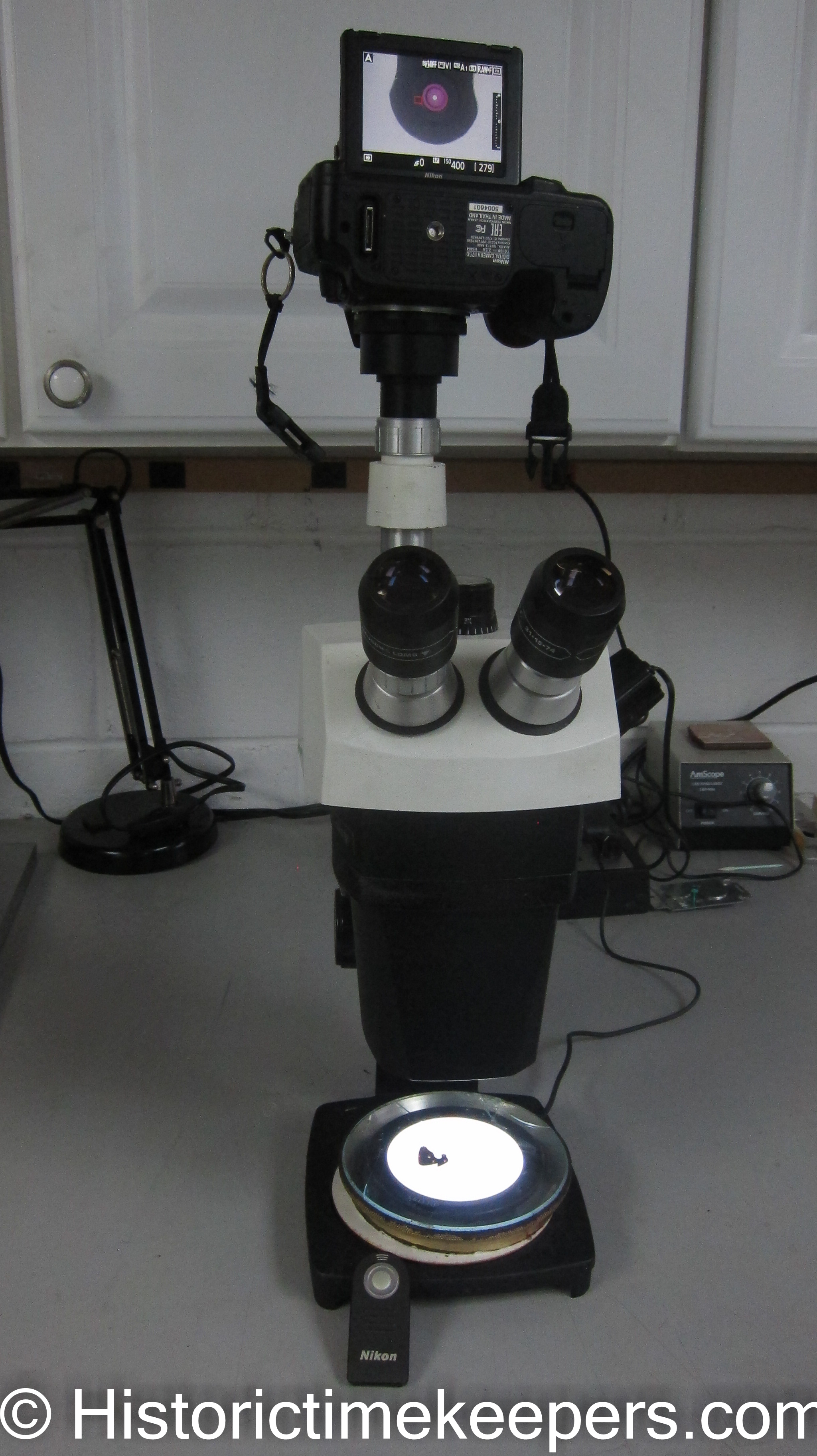
Above: Documenting jewel holes with Bausch microscope and Nikon tilt screen camera. Note use of wireless shutter release.
Cleaning Systems: I use an L&R Tempo 350; it is a four-solution automatic ultrasonic system. I use Zenith solutions; one of the cleaner and 3 of the rinse. The first rinse gets cloudy when it gets replaced by the contents of the second rinse jar, which is refilled from the third jar. Third jar is always fresh rinse. All the photos I show of parts and jewels are "as from the cleaner". I have no need to touch them up with IPA, heptane or with a swab.
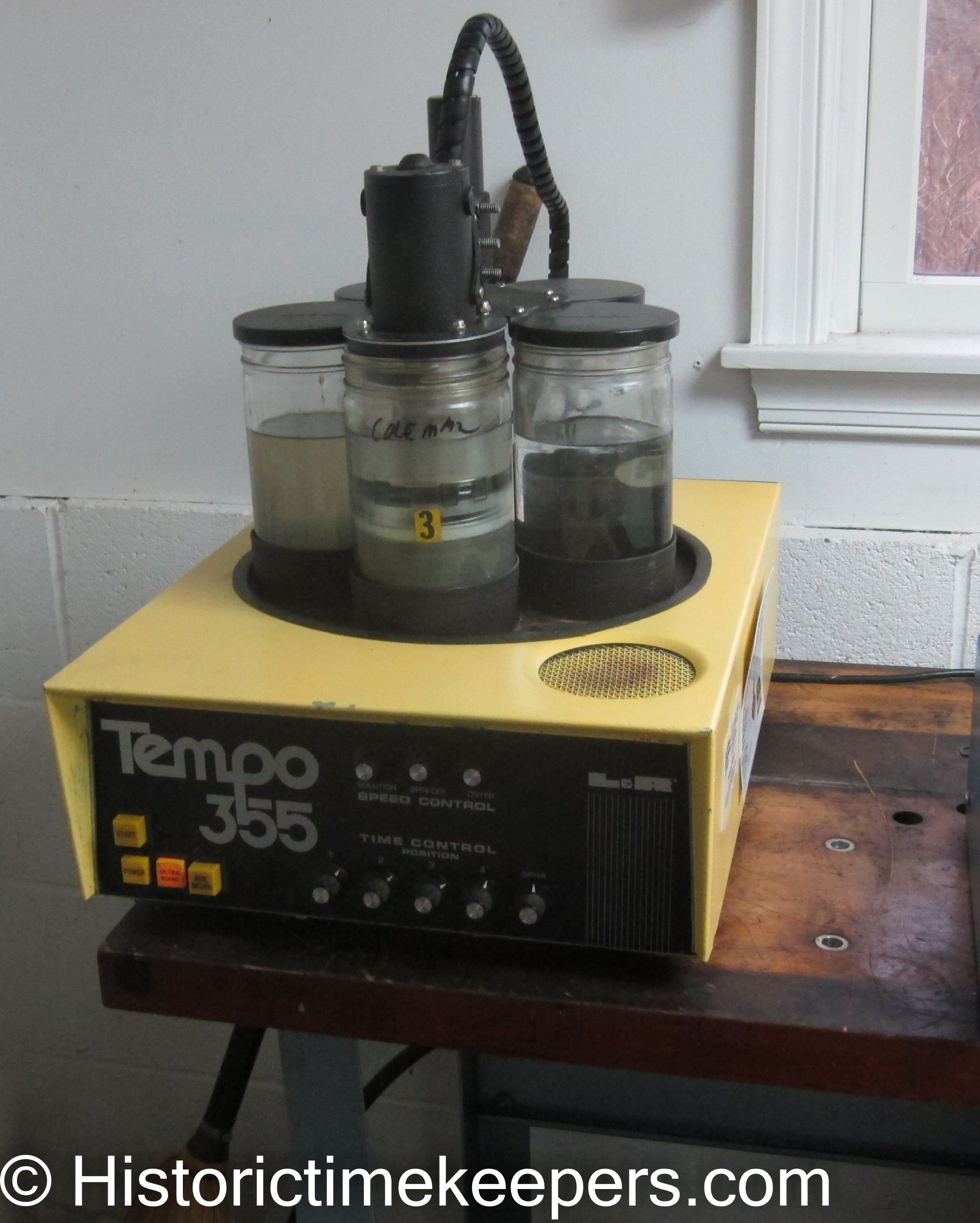
There is an alternative that is identical in results to the Watchmaster/ Portescap cup based systems.
Use a traditional ultrasonic tank like the clockmakers and dentists use. Buy some 35mm or 120mm film developing tanks. Using a water bath in the tank, suspend the cups on the water using a basket/tray that should come with the machine to keep things off the tank bottom. You can copy the other cup based systems by using four developing tanks, each with one of the four solutions.
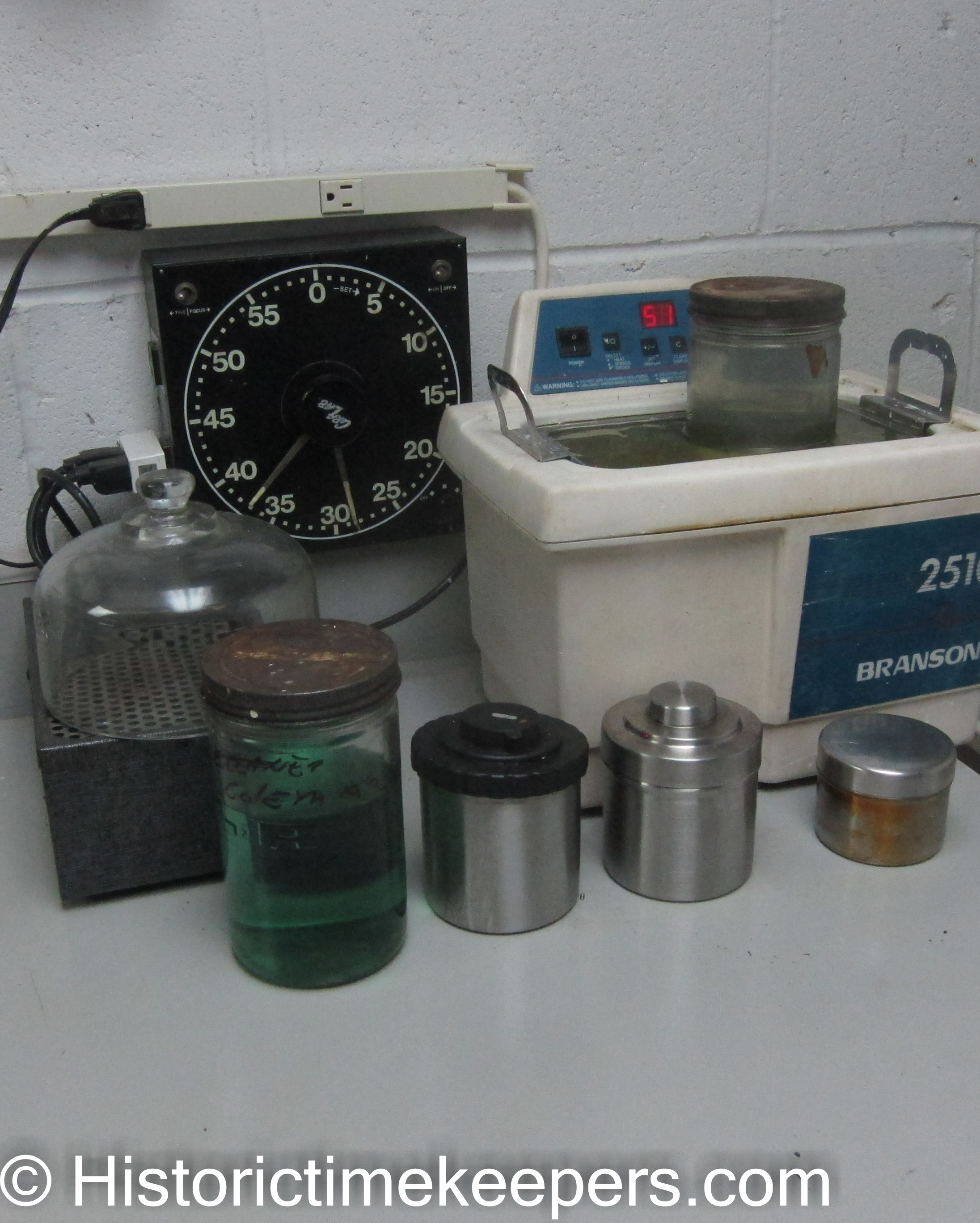
I use this to pre-clean every movement, which extends the life of the solutions in my Tempo, as well as avoiding getting my bench dirty.
I very seldom need to touch jewels or plates with this system. As you were taught, the parts need to be chemically clean so as not to react with or encourage the spread of the oils.
To this end, I use finger cots. For random stains, I use reagent grade IPA from a pump dispenser on a surgical foam-tipped swab. I do not use pith near the movement and certainly no Rodico. Rodico is good for looking at things under the microscope and getting cap jewels out of Incabloc settings. But that is it.
Read my thoughts on watchmaking myths that make no sense when you think about it here.
TOOLS & TECHNIQUES:
Measurement See Measurement in Watchmaking
Tools that cannot be purchased: You will find yourself frustrated with available tools once you start working in restoration. For many pieces there simply is no mass produced movement holder, for example. For other pieces like wrist watches, you can make holders that are less expensive and far more useful than those commercially available. I make watch holders out of polycarbonate tubing that clamp the entire movement and allow light to come in under the movement, making inspection much easier. I do not like the Universal movement holders with parallel jaws that close via a screw (Bergeon). Far too many times I have had the plates flip when I was tightening a screw that was not directly over the jaw.
I do a lot of aircraft clocks and Model 22s. So it made sense for me to make movement holders for those as well.
If emulation is a form of flattery, then I am flattered someone took my idea for these holders to sell on ebay, particularly the M22 workholder. While I think buying a M22 workholder for $50 is not a bad deal, if you are on a path to BE a watchmaker you should use the opportunity to make your own tools to develop your skills in machining.
As an aside, I think that seller thought the white Delrin holder for pocket watches was for the M22; he has too many slots that serve no purpose. The M22 workholder is the brass holder on the right in the group photo.
Also, you can see I make anvils and pushers out of Delrin. You need to be able to make simple tooling.
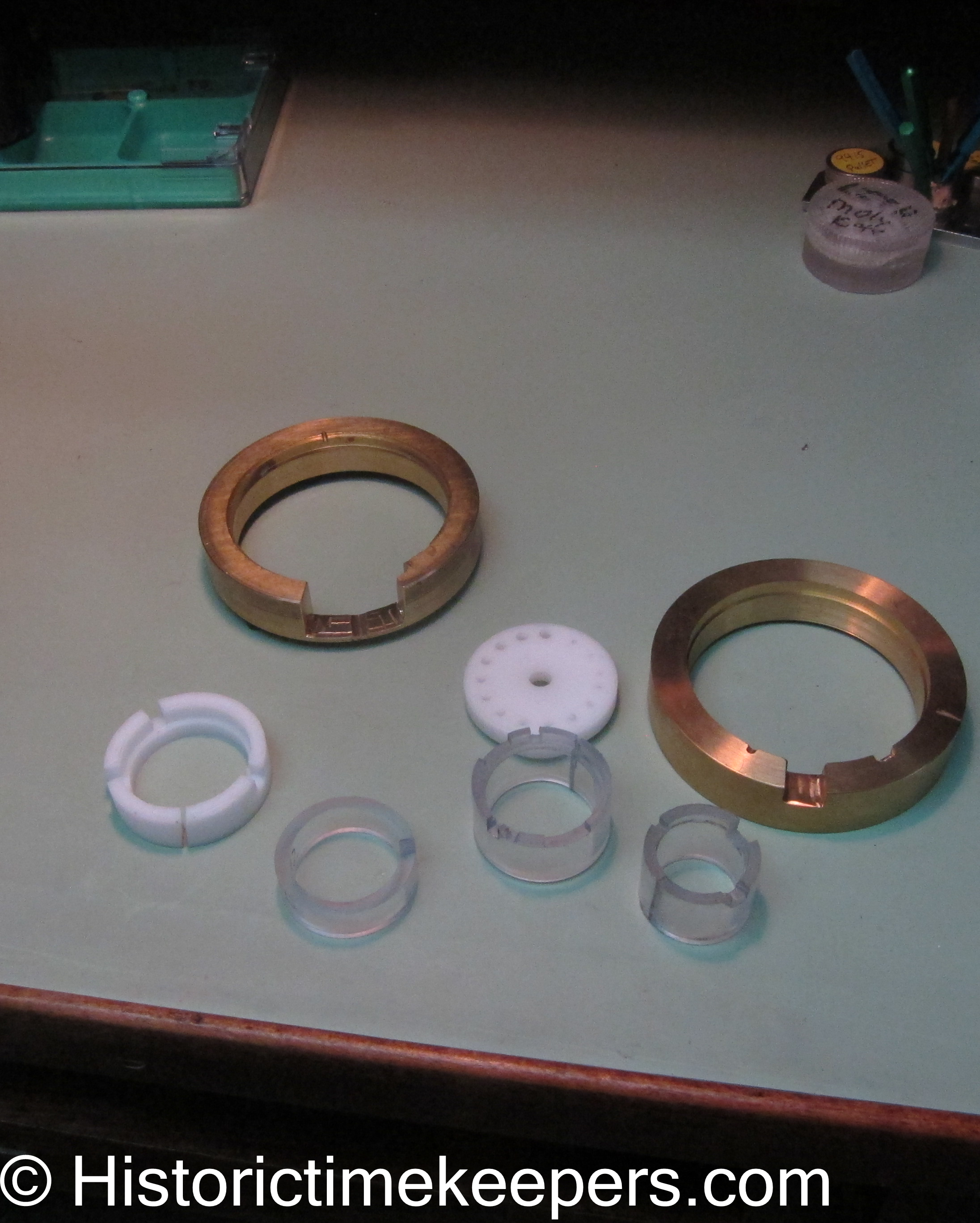
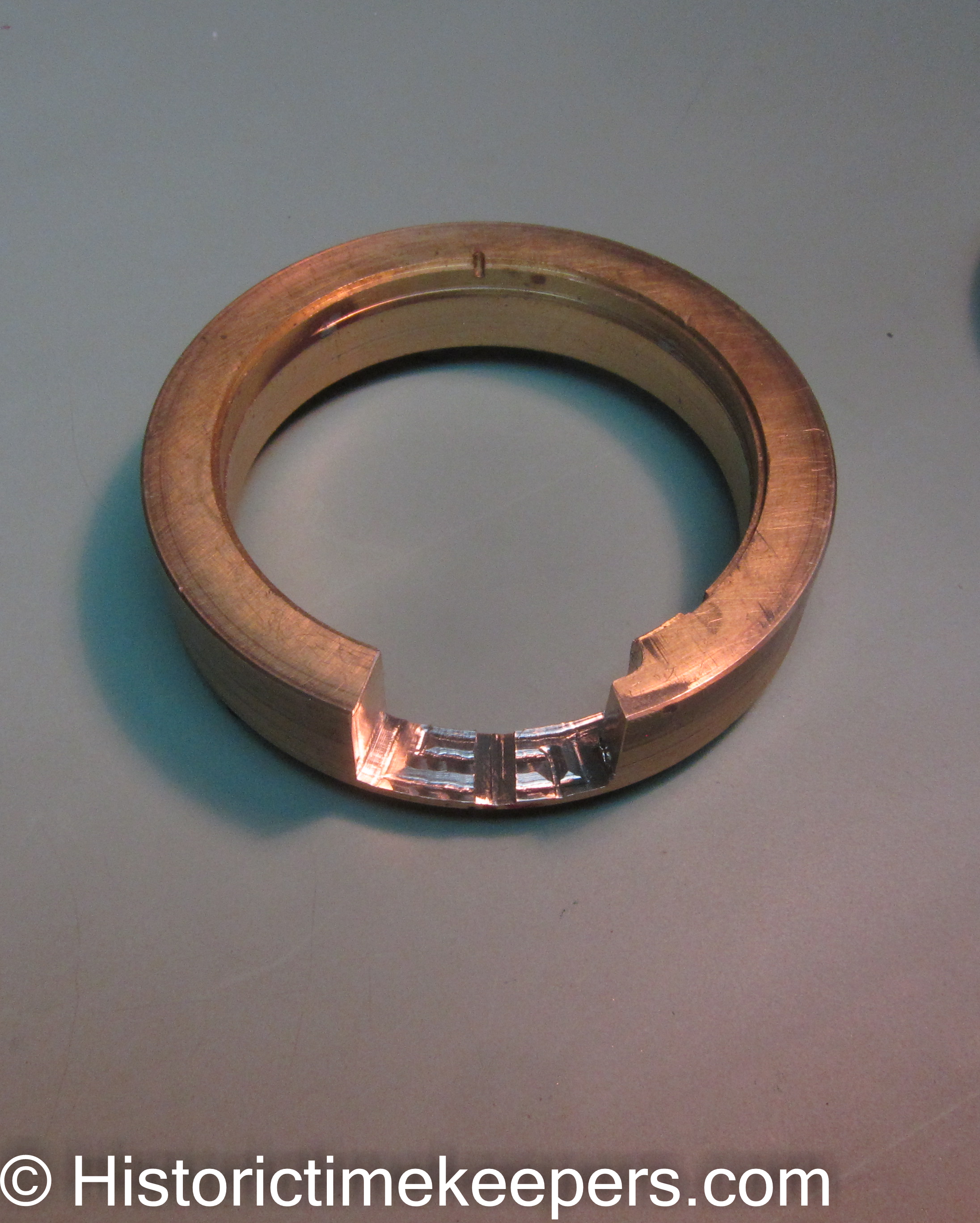
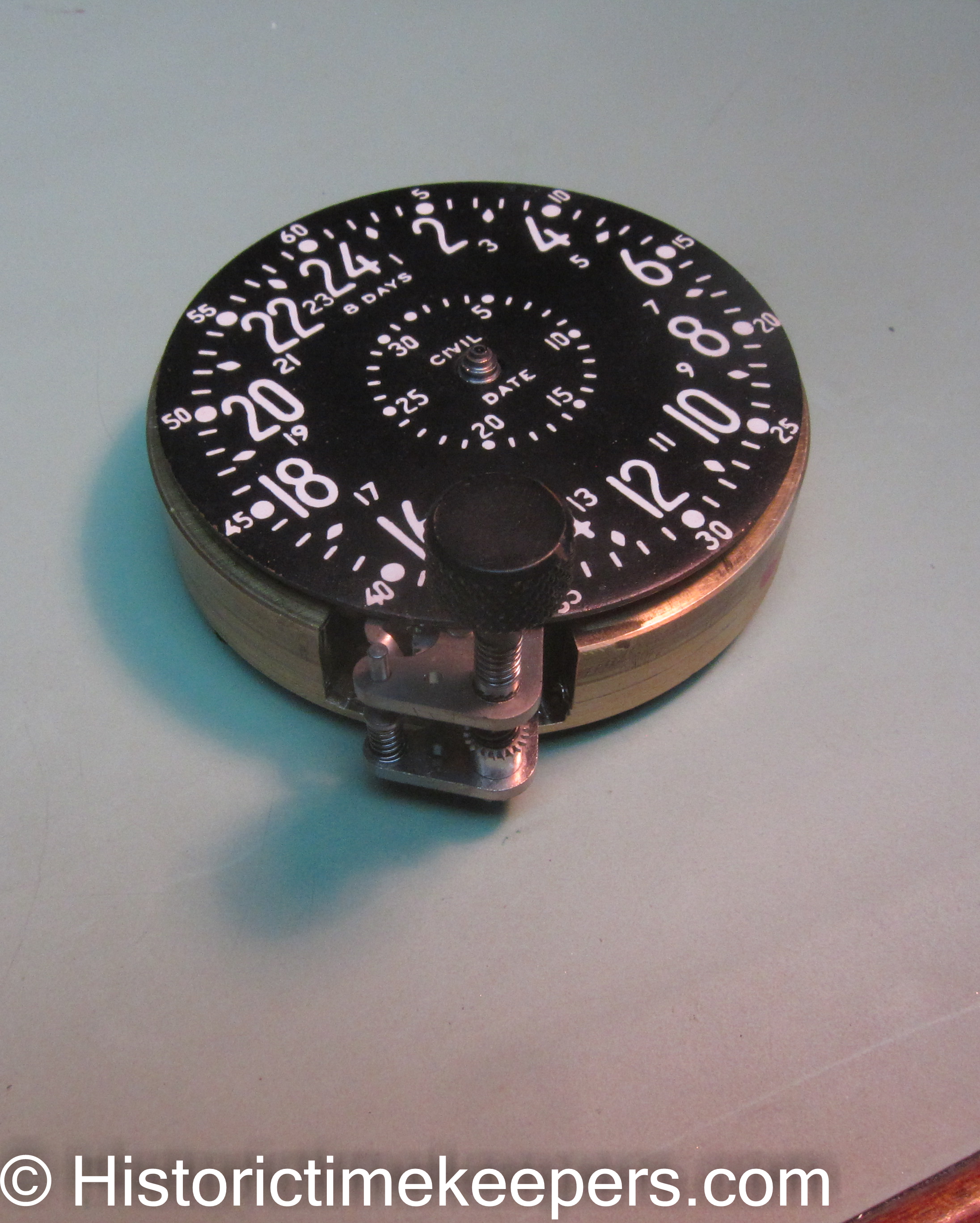
Bench Air: Much less important than the suction. In fact, I mainly use it on the light machine bench behind my work station. But, to keep it quiet, I have a pancake compressor in another room covered with fiberglass insulation and then ran the hose to the bench through the ceiling. I also adjusted the pressure to the bench to be very low. I have a separate full- pressure air compressor line run to the sink.

Bench Covering and Management: An effective, easy on the eyes and inexpensive bench surface is drafting board cover. It comes in a long roll for about $50 from any art store and will cover at least three bench tops. It is also very easy to clean with the usual cleaners, although acetone will ruin it. I cut the material to shape for my bench, and then secure it with double-sided tape used for attaching leatherette to camera bodies and such. After a year or two, I replace the material and move it to some other surface.
If you look at my bench area you will see two things. One, I keep the bench top itself free of almost everything but the work. Much easier to find flipped cap jewels that way. It also helps that I have the sides and top enclosed. Under the bench all vertical-to-floor surfaces are sealed with tape for the obvious reasons. All tools, movement trays and such are kept on a shelf above the bench.
Bench Vacuum: Look around ebay for a vacuum source from a surgical suite. They can be had for under $50. Connect it to a bench switch and run the hose to your bench. Make a nozzle out of ball point pen parts and make a filter to catch parts by cutting an old mesh basket into round pieces that fit the inside diameter of your hose.
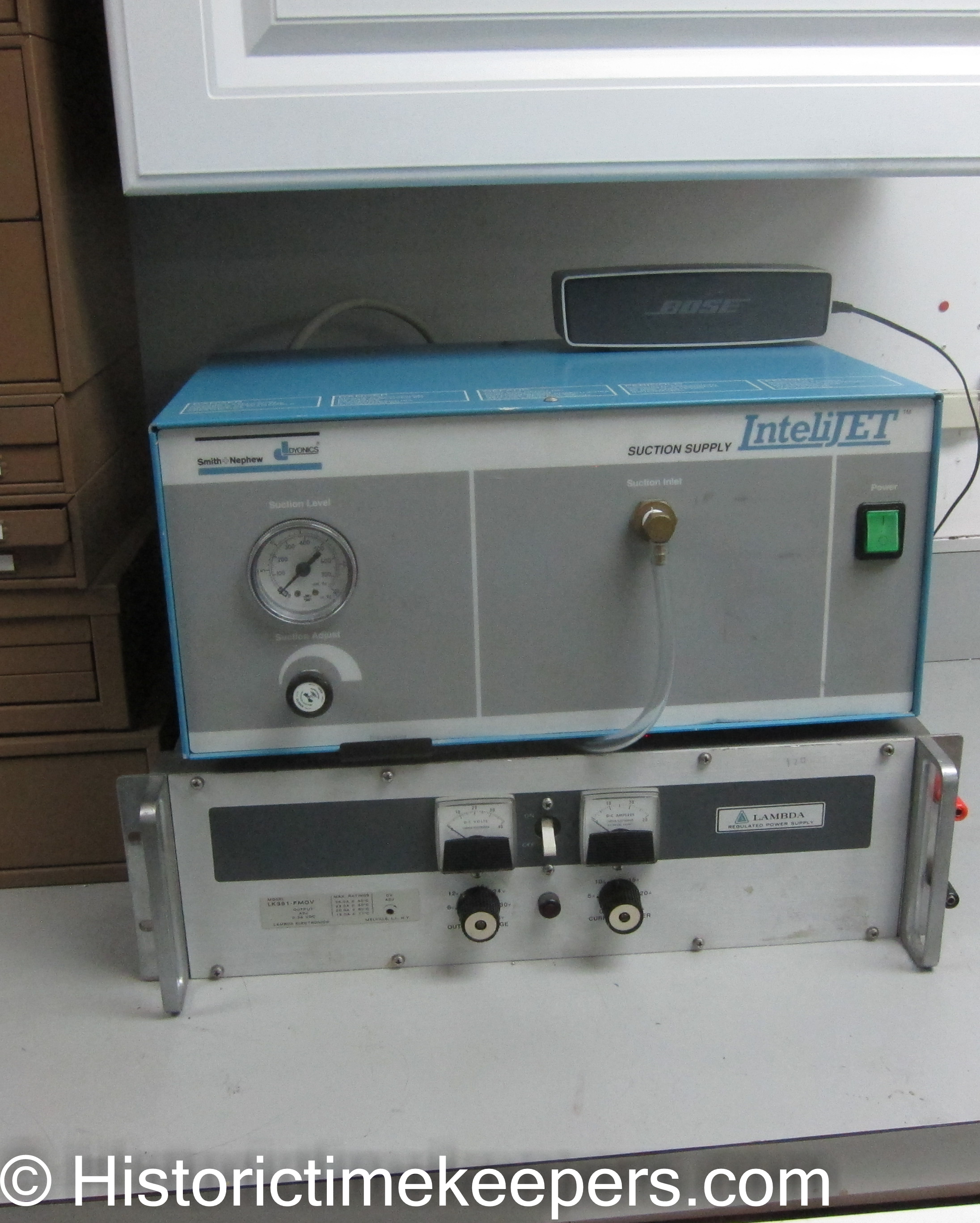
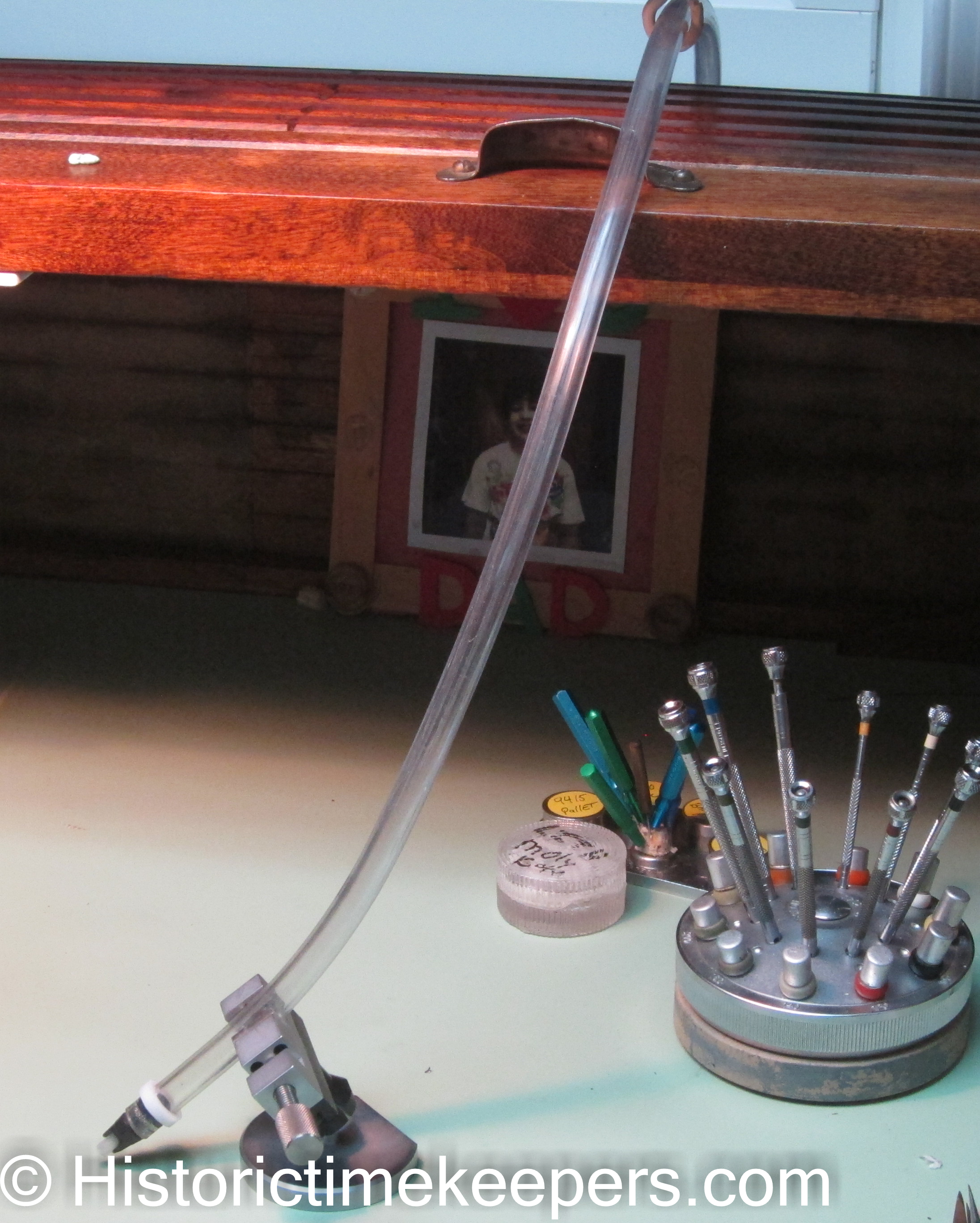
Blueing and annealing: In school we all used a tripod platform over an alcohol lamp maybe with brass filings. Very scary come exams! Again, go to ebay and buy a lab quality adjustable hotplate. To make it even better, take one of your wife's/ partner's 4-cup Pyrex measuring cups (do not tell your partner/wife!) and oven thermometer to make an effective oven of your hotplate. Mark the adjustment knob at the setting that gives you the color blue you like.
Microscope: If you look at some of the more recent photos on my website (where my hair is grayer), you will see I am using a Nikon SMZ 1B with a .7 Barlow lens underneath. This gives me about 6 inches of working room, good depth of field and magnification range of about 5X to 25X. If I need more I either go to 15X eyepieces or remove the Barlow.
Do NOT scrimp on the microscope. Get a Nikon, American Optical 570 or a Bausch and Lomb StereoZoom 5, 6,or 7. These scopes were the workhorses of industry and are extremely robust and well sealed. I like the Nikon SMZ 1B because its eyepiece tubes come off the body at a shallower angle reducing my seating height.
The Nikon and B&L scopes also are very easy for a watchmaker to maintain as long as you do not disassemble the individual lens cells. There is a lot of information on the Internet about how to evaluate these very important tools.
To see more about microscopes visit my page on Microscopes in Watchmaking.
Shellac: It goes bad within a year or two. Do not waste your time on some "old timer's" stash. Buy flake shellac from a woodworker store or jewelry house. And learn how to use it to center work on a lathe faceplate!
Solder: I cannot remember when I last used solder in the shop. But if you do have it, for crying out loud make sure it is rosin core solder and not acid flux solder (TIX). The acid fumes will destroy your tools and material in a hurry and there is nothing in watch or clock making that requires more strength than that provided by electronic solder (unless it needs to be saved via silver soldering which is a skill in itself).
Super Glue: Only those who never had to make a new part turn their nose up to super glue in the shop. It is excellent for holding glass hard templates or original broken pieces on the steel as you cut out the replacement. I also use it to fixture pieces for milling and surface grinding. And Loctite goes on every repivot. There are different formulations of both, and I use Prism 411 for the super glue. It is resilient and easily removed with acetone or slight heat.
Tweezers: I now use only bronze. They are more expensive, but they do not mark parts and are very easy to dress with a file.